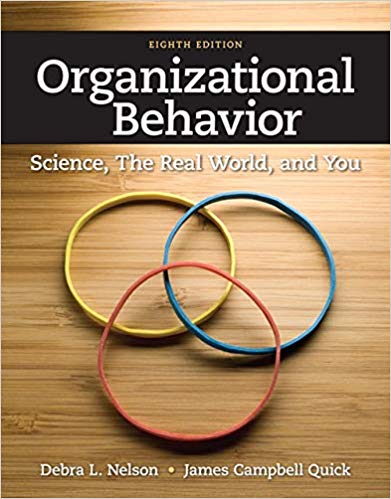Organizational Behavior Science, The Real World, and You 8th Edition by Debra L. Nelson – Test Bank
CHAPTER 6—LEARNING AND PERFORMANCE MANAGEMENT
MULTIPLE CHOICE
1.QuikTrip holds to the gospel of rigorously hiring “nice people” as well as training from within, promoting from within, and paying the “right” people well to reinforce performance. These policies are more consistent with:
|
a. |
internal theories of motivation |
|
b. |
Herzberg’s two factor theory |
|
c. |
Theory Y assumptions |
|
d. |
external theories of motivation |
ANS: D PTS: 1 DIF: Moderate REF: p. 198|p. 223
NAT:AACSB: Reflective Thinking | AACSB: Motivation Concepts
TOP: Thinking Ahead | Looking Back MSC: K&C
2.All of the following are ways QuikTrip motivates employees by emphasizing external theories of motivation:
|
a. |
promoting from within |
|
b. |
training from within using employees who are personal trainers |
|
c. |
paying employees well |
|
d. |
prioritizing individual’s multiple goals by the valence and expectancy of a particular reward |
ANS: D PTS: 1 DIF: Moderate REF: p. 198
NAT:AACSB: Reflective Thinking | AACSB: Motivation Concepts
TOP: Thinking Ahead MSC: K&C
3.In terms of the work environment, learning:
|
a. |
takes place through formal training programs |
|
b. |
is primarily the cognitive activity of acquiring knowledge |
|
c. |
is ad hoc and accidental |
|
d. |
is primarily a change in behavior acquired through experience and knowledge acquisition |
ANS: D PTS: 1 DIF: Moderate REF: p. 198
NAT:AACSB: Reflective Thinking | AACSB: Motivation Concepts
TOP: Learning in Organizations MSC: K&C
4.The behaviorist approach to learning assumes observable behavior is a function of:
|
a. |
both the person and the environment |
|
b. |
external cues |
|
c. |
its consequences |
|
d. |
the interaction between the affect and cognitive components of an individual |
ANS: C PTS: 1 DIF: Easy REF: p. 198
NAT:AACSB: Reflective Thinking | AACSB: Motivation Concepts
TOP: Learning in Organizations MSC: K&C
5.In the animal learning research of Pavlov, the sound of the bell was the:
|
a. |
conditioned response |
|
b. |
unconditional stimulus |
|
c. |
conditioned stimulus |
|
d. |
consequence of the dog’s salvation |
ANS: C PTS: 1 DIF: Hard REF: p. 199
NAT:AACSB: Reflective Thinking | AACSB: Motivation Concepts
TOP: Classical Conditioning MSC: Analysis
6.Which of the following is NOT a limitation of classical conditioning?
|
a. |
Humans are more complex and less amenable to simple cause-and-effect conditioning. |
|
b. |
Behavioral environments in organizations are complex and not very amenable to single stimulus-response manipulations. |
|
c. |
Unconditioned responses and unconditioned stimulus have not been connected in humans. |
|
d. |
Complex human decision making makes it possible to override simple conditioning. |
ANS: C PTS: 1 DIF: Moderate REF: p. 199
NAT:AACSB: Reflective Thinking | AACSB: Motivation Concepts
TOP: Classical Conditioning MSC: Analysis
7.Modifying behavior so that a conditioned stimulus is paired with an unconditioned stimulus and elicits an unconditioned response defines:
|
a. |
operant conditioning |
|
b. |
classical conditioning |
|
c. |
reinforcement |
|
d. |
learning |
ANS: B PTS: 1 DIF: Easy REF: p. 198
NAT:AACSB: Reflective Thinking | AACSB: Motivation Concepts
TOP: Classical Conditioning MSC: K&C
8.A person working at a computer terminal may get lower back tension as a result of poor posture. If the person becomes aware of that tension only when the manager enters the work area, then the person may develop lower back tension at the appearance of the manager. This scenario would be an example of:
|
a. |
operant conditioning |
|
b. |
classical conditioning |
|
c. |
paired reinforcement |
|
d. |
behavior modification |
ANS: B PTS: 1 DIF: Moderate REF: p. 198
NAT: AACSB: Analytic | AACSB: Motivation Concepts TOP: Classical Conditioning
MSC: Application
9.A form of operant conditioning that has been used successfully to shape organizational behavior is known as:
|
a. |
job enrichment |
|
b. |
organization development |
|
c. |
employee empowerment |
|
d. |
organizational behavior modification |
ANS: D PTS: 1 DIF: Moderate REF: p. 199
NAT:AACSB: Reflective Thinking | AACSB: Motivation Concepts
TOP: Operant Conditioning MSC: K&C
10.Operant conditioning is based on the notion that behavior is a function of:
|
a. |
seated beliefs |
|
b. |
perception and thinking |
|
c. |
unconscious drives |
|
d. |
its consequences |
ANS: D PTS: 1 DIF: Easy REF: p. 199
NAT:AACSB: Reflective Thinking | AACSB: Motivation Concepts
TOP: Operant Conditioning MSC: K&C












Reviews
There are no reviews yet.